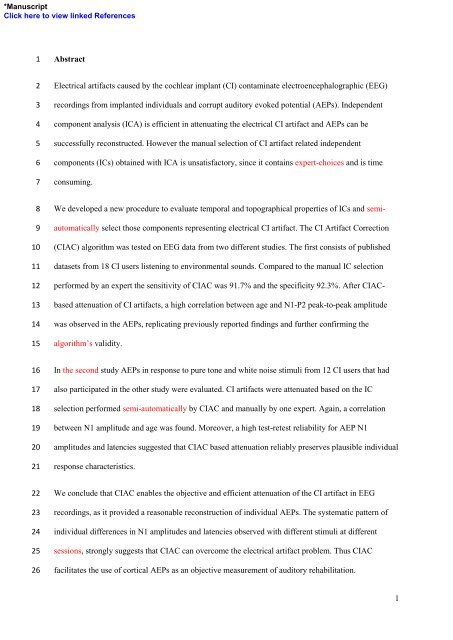Elsevier Editorial System(tm) for Hearing Research Manuscript Draft ...
Elsevier Editorial System(tm) for Hearing Research Manuscript Draft ...
Elsevier Editorial System(tm) for Hearing Research Manuscript Draft ...
Create successful ePaper yourself
Turn your PDF publications into a flip-book with our unique Google optimized e-Paper software.
*<strong>Manuscript</strong><br />
Click here to view linked References<br />
1<br />
2<br />
3<br />
4<br />
5<br />
6<br />
7<br />
8<br />
9<br />
10<br />
11<br />
12<br />
13<br />
14<br />
15<br />
16<br />
17<br />
18<br />
19<br />
20<br />
21<br />
22<br />
23<br />
24<br />
25<br />
26<br />
Abstract<br />
Electrical artifacts caused by the cochlear implant (CI) contaminate electroencephalographic (EEG)<br />
recordings from implanted individuals and corrupt auditory evoked potential (AEPs). Independent<br />
component analysis (ICA) is efficient in attenuating the electrical CI artifact and AEPs can be<br />
successfully reconstructed. However the manual selection of CI artifact related independent<br />
components (ICs) obtained with ICA is unsatisfactory, since it contains expert-choices and is time<br />
consuming.<br />
We developed a new procedure to evaluate temporal and topographical properties of ICs and semi-<br />
automatically select those components representing electrical CI artifact. The CI Artifact Correction<br />
(CIAC) algorithm was tested on EEG data from two different studies. The first consists of published<br />
datasets from 18 CI users listening to environmental sounds. Compared to the manual IC selection<br />
per<strong>for</strong>med by an expert the sensitivity of CIAC was 91.7% and the specificity 92.3%. After CIAC-<br />
based attenuation of CI artifacts, a high correlation between age and N1-P2 peak-to-peak amplitude<br />
was observed in the AEPs, replicating previously reported findings and further confirming the<br />
algorithm’s validity.<br />
In the second study AEPs in response to pure tone and white noise stimuli from 12 CI users that had<br />
also participated in the other study were evaluated. CI artifacts were attenuated based on the IC<br />
selection per<strong>for</strong>med semi-automatically by CIAC and manually by one expert. Again, a correlation<br />
between N1 amplitude and age was found. Moreover, a high test-retest reliability <strong>for</strong> AEP N1<br />
amplitudes and latencies suggested that CIAC based attenuation reliably preserves plausible individual<br />
response characteristics.<br />
We conclude that CIAC enables the objective and efficient attenuation of the CI artifact in EEG<br />
recordings, as it provided a reasonable reconstruction of individual AEPs. The systematic pattern of<br />
individual differences in N1 amplitudes and latencies observed with different stimuli at different<br />
sessions, strongly suggests that CIAC can overcome the electrical artifact problem. Thus CIAC<br />
facilitates the use of cortical AEPs as an objective measurement of auditory rehabilitation.<br />
1
















